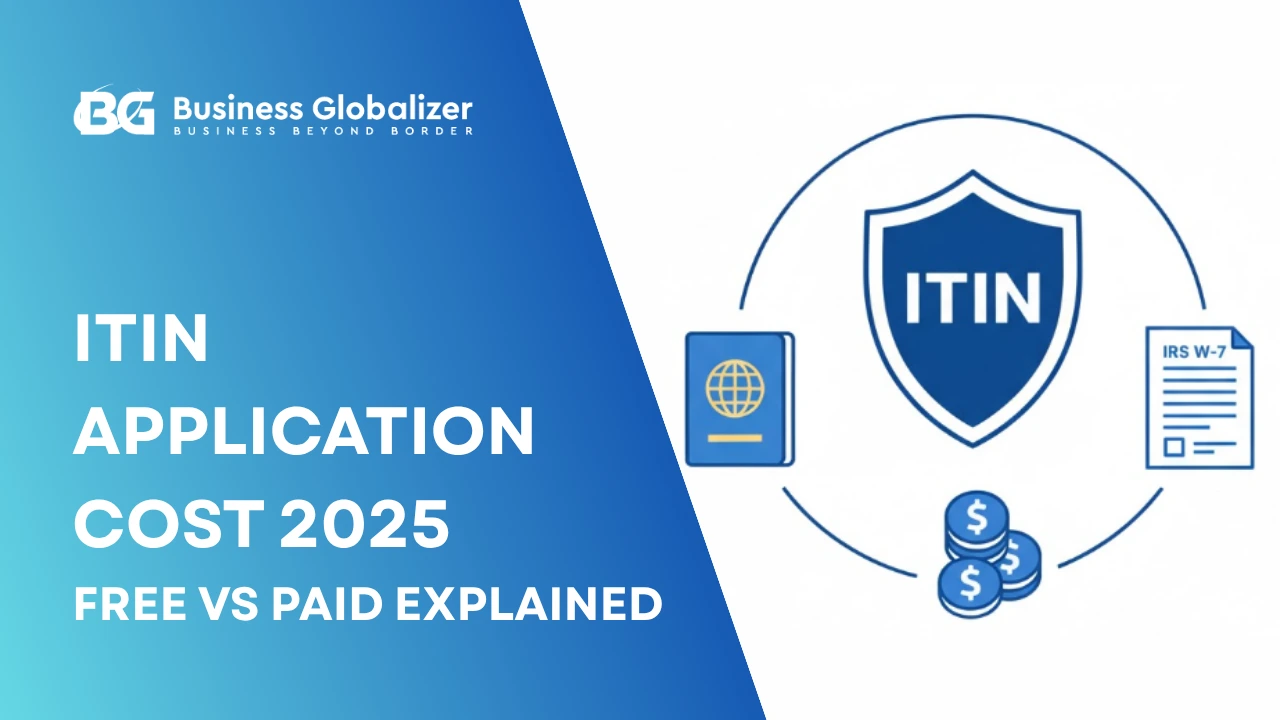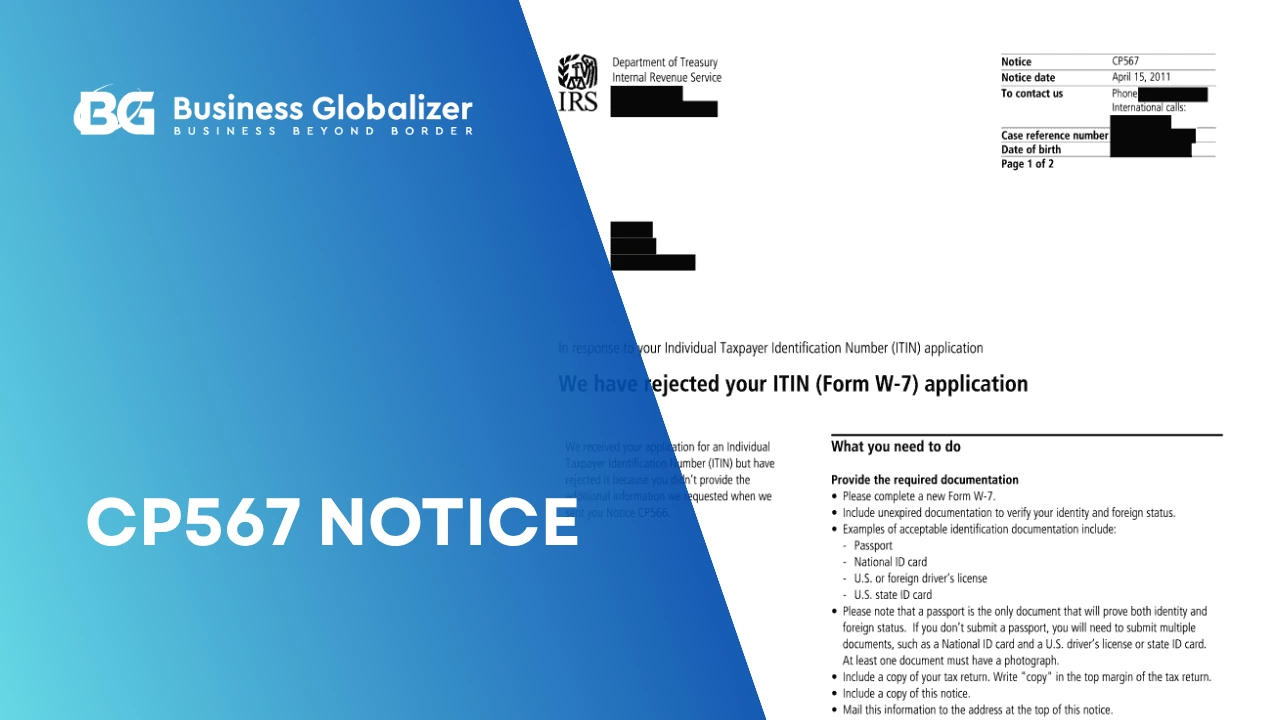Let’s start with the feeling… You waited weeks, maybe months, for your ITIN, and then that official IRS letter shows up in the mail: Notice CP567. You open it, and read ‘ITIN application rejected’!
Frustrating, right? I know. Especially when you’ve followed every YouTube guide, checked every just the right box, and even double-checked your passport copy.
The good news? An ITIN rejection doesn’t mean your U.S. journey stops. It usually means the IRS just wants a clearer picture; one you can easily and absolutely fix with the right steps.
So, let’s just talk about why your ITIN application got rejected, what those rejection letters really mean, and how to do it right the next time.
What Is an ITIN? Who Actually Needs It?
Before we jump into the main topic of “ITIN application rejected,” let’s clear our basics up: what is an ITIN, and why people need this identification number in the first place?
Well, an ITIN or Individual Taxpayer Identification Number is a nine-digit number. And this is issued by the IRS to people who need to pay or report U.S. taxes but aren’t eligible for an SSN (Social Security Number).
Simply said, it’s how the U.S. tax system keeps nonresidents, foreign business owners, and dependents “on the record” for tax purposes. Legally and correctly.
So, who actually needs an ITIN? And when? Let’s look at the most common scenarios here:
- Scenario 1: You own a U.S. company but live outside the U.S. (the most common situation).
- Scenario 2: You’re married to a U.S. citizen or a resident alien.
- Scenario 3: You’re a dependent of a U.S. citizen or resident alien.
- Scenario 4: You’ve sold a property in the U.S. and need to report the income.
- Scenario 5: You own property in the U.S. and need to report rental or investment income or any other ongoing tax obligations.
- Scenario 6: You’re a non-U.S. student, professor, or researcher who needs to file a U.S. tax return.
- Scenario 7: You’re a non-U.S. resident who just needs to file a federal income tax return.
What Happens When an ITIN Application Is Rejected?
Now that we’ve covered why your ITIN actually matters, let’s get into the real talk: what happens when it’s rejected.
When the IRS rejects your ITIN application, it simply means they couldn’t process your Form W-7 because something didn’t quite add up. Maybe a document was missing, maybe a copy wasn’t clear enough, or maybe a small detail on the form didn’t match.
You’ll get a letter from the IRS, usually Notice CP567, explaining exactly what went wrong. It’s not a punishment, just a notice that your application needs correction.
Here’s what that practically means:
- Your ITIN wasn’t issued.
- Your supporting documents (like your passport copy) will be returned to you.
- You’ll need to correct the mistake and reapply.
From here, it’s all fixable. And that’s exactly what we’ll discuss in an easier way.
Why Was My ITIN Application Rejected? And What to Do About It?
Let’s be honest, when you see your ITIN application rejected, it feels personal. You start wondering, “Did I miss something big?” or “Will I ever get this approved?”
But in most cases, the problem isn’t serious; just a small mismatch or missing detail. The IRS is strict, but not unreasonable. They just want every dot and line on your Form W-7 and documents to tell the same story.
So, if you’re wondering why your ITIN application was rejected, take a look below to know the most common reasons, and how to deal with them:
1. Missing or Invalid Supporting Documents
To be honest, this one trips up more people than anything else. Maybe the passport copy wasn’t clear enough, maybe it wasn’t properly certified, or maybe you sent something the IRS simply doesn’t accept. Small details, big consequences.
Fix it: Always send the real thing, not just a random copy.
The IRS only accepts original documents or certified copies issued directly by the authority (not notarized ones). If mailing your passport makes you nervous, totally fair, just go through a Certified Acceptance Agent (CAA) instead.
They can verify your identity in person or even online, so you don’t have to risk sending your original passport through the mail.
2. Incorrect or Incomplete Form W-7
Even a small slip on your Form W-7 can trigger an ITIN rejection. Maybe you picked the wrong reason code, left out your birth date, or simply forgot to sign it. Yes, it happens to more people than you think.
Here’s how to fix it: Grab a fresh W-7 and go slow. Line by line. Make sure every detail matches your ID and tax return exactly. And if English isn’t your strong suit, ask someone you trust to give it a quick look before you send it off.
3. Unclear or Incorrect Reason for Applying
Here’s a less obvious one. But very common. If the IRS can’t clearly see why you’re applying for an ITIN, they’ll reject it outright. For instance, if you tick “for filing a tax return” but don’t attach one, or if you choose “dependent” without proof, the IRS treats the application as incomplete.
Fix it: Pick the right reason code that truly fits your case:
- Owning a U.S. company? Choose “Nonresident alien required to obtain ITIN to claim tax treaty benefit.”
- Filing a tax return? Choose “Nonresident alien required to file a U.S. tax return.”
- Dependent or spouse? Select the dependent/spouse option and include supporting evidence.
If you’re unsure which applies to you, consult a CAA, they can help you select the correct code and supporting documents, so the IRS doesn’t reject it again.
4. No Federal Tax Return Attached (When Required)
If you didn’t include a federal tax return, your ITIN application might be rejected unless you qualified for an exemption. The IRS needs to confirm that there’s a legitimate filing need.
Fix it: Attach your complete U.S. tax return. If you qualify for an exception (like for bank interest or treaty benefits), include the exact proof the IRS requests.
5. Expired or Invalid Identification
Expired passports, old visas, or unclear photo IDs often lead to rejection because the IRS can’t verify your identity or current status.
Fix it: Renew your passport or ID before reapplying. Make sure copies are clear and up-to-date.
6. Duplicate or Previously Issued ITIN
Sometimes, people forget they’ve already had an ITIN issued years ago. When the IRS finds a record that matches your info, it freezes the new request.
Fix it: If you think you had one, include a short note in your reapplication explaining your old ITIN or attaching the previous letter (if you still have it). The IRS will merge or reactivate the record.
7. Using an Old Form W-7 Version
Yes, even this happens. If you used an older version of the form, the IRS system automatically rejects it.
Fix it: Always download the latest Form W-7 directly from the IRS.gov website before applying. Outdated versions may look similar, but the IRS scans for the version code at the top.
8. Information Mismatch Between W-7 and Tax Return
Your ITIN form and tax return must tell the same story: name, address, filing status, and dates. If anything doesn’t align, it raises a red flag.
Fix it: Double-check that your spelling, date of birth, and filing information are correct and match exactly across every document. Even a small mismatch (like “Steven” vs. “Stephen”) can cause delays.
In short, most ITIN rejections happen because something didn’t match, not because you did anything wrong. Once you correct what the IRS flagged, your reapplication stands a much stronger chance of approval.
And if you want to skip the trial and error, a Certified Acceptance Agent can review your documents, fill out the correct reason code, and submit your application directly to the IRS. It’s simple like that.
What to Do If ITIN Application Is Rejected
Let’s face it, seeing “ITIN application rejected” in that IRS mail stings. But here’s the truth: it’s not a dead end. It’s the IRS saying, “We just need a bit more from you.”
Most people who fix what’s listed in their rejection notice and reapply correctly get approved on their next try. So, let’s discuss what to do if your ITIN application is rejected. Calmly and correctly.
1. Read the IRS Rejection Letter Carefully (CP567)
When your application gets rejected, the IRS sends you a letter called Notice CP567. It tells you why your ITIN was rejected; missing document, expired ID, unclear reason, whatever it is.
Don’t toss it aside. That letter is your roadmap. It’s how you fix exactly what the IRS needs, instead of guessing.
2. Fix the Issue Mentioned
You don’t have to start over completely. Just correct what’s wrong. Go line by line through your rejection notice.
- If your passport copy was unclear, get a certified copy or use a Certified Acceptance Agent (CAA) to verify it for you.
- If your tax return wasn’t attached, include it this time.
- If your reason code didn’t make sense, choose the correct one that matches your case (for example, business owner, dependent, or nonresident filer).
Think of it as editing, not rewriting.
3. Double-Check the Basics
Many ITIN rejections come from simple misses: no signature, mismatched birth date, or expired ID. Before you reapply, take five minutes to check every small detail. The IRS notices everything.
4. Reapply Through the Right Channel
You’ve got three ways to reapply:
- By mail: For applicants inside the U.S. with simple cases.
- IRS Taxpayer Assistance Center (TAC): For those who want to hand in documents directly.
- Through a Certified Acceptance Agent (CAA): This is the best and easiest route if you’re outside the US. A CAA (like our in-house team at Business Globalizer) can verify your passport on your behalf. No need to mail originals across borders.
If your first ITIN application was rejected due to ID or document issues, using a CAA can prevent that from happening again.
5. Wait for the Approval (and Keep an Eye on the Mail)
After reapplying, give it around 7–11 weeks for processing. If you’re applying from outside the U.S., expect a few more weeks.
Don’t send multiple applications. That just confuses the system.
6. Learn from It, So It Doesn’t Happen Again
A rejection isn’t a failure. It’s a small detour. Keep your paperwork safe, note what went wrong, and next time, you’ll glide through the process.
Pro Tip: Not sure why your ITIN got rejected or what went wrong? Don’t roll the dice with another round of forms. A Certified Acceptance Agent (CAA) can take one look at your rejection letter, spot the mistake instantly, and resubmit it the right way, saving you weeks of waiting and a whole lot of frustration.
How to Reapply for ITIN
Once you’ve fixed the problem, it’s time to send your application again. But smarter this time.
When it comes to how to reapply for ITIN, treat it like a second chance where you already know all the traps. The goal isn’t speed; it’s accuracy.
Let’s learn how to do it right:
1. Start Fresh with a New Form W-7
Always use a brand-new Form W-7. Signed, dated, and printed from the IRS.gov website. Using an old version is one of the quickest ways to get your ITIN rejected again.
Before submitting, make sure:
- The reason code truly fits your case.
- All personal details (name, birth date, address) must match your passport or tax return.
- You’ve signed and dated the form yourself; yes, people still forget that.
2. Attach All the Required Documents. Again.
The IRS doesn’t keep old submissions. You must attach all documents again, even those from your first application.
That means:
- A valid passport or certified copy.
- A complete federal tax return (if required).
- Any additional documents relevant to your reason code (like marriage certificate for spouse applications or property sale papers for investors).
If your ITIN application was rejected due to unclear ID or missing proof, this is your chance to get it perfect.
3. Write a Short Cover Note (Optional, But Smart)
It’s not required, but adding a one-paragraph note helps. Simply say something like:
“This is a corrected ITIN application. My previous application was rejected due to [state reason from your CP567 notice]. The issue has now been resolved.”
It shows the IRS you understand the process and makes your reapplication easier to review.
4. Submit Through the Right Channel
You’ve got options:
- Mail it (if in the U.S.).
- Visit an IRS TAC (if you want to hand it in yourself).
- Or use a Certified Acceptance Agent (CAA), especially if you’re outside the U.S. or don’t want to risk mailing original documents.
Most reapplications handled by CAAs get approved faster because the identity verification part, the trickiest bit, is handled upfront.
5. Track and Wait
Processing takes 7–11 weeks, sometimes a little more during peak season. Keep copies of everything: your W-7, tax return, and certified documents, so you have a record if you need to follow up.
What I’m trying to say is, reapplying for an ITIN isn’t complicated; it’s just about being careful the second time around. Once you correct what caused your ITIN application rejection, the approval rate shoots up dramatically.
If you’d rather not risk a second rejection, working with a Certified Acceptance Agent (CAA) can make the process smooth and stress-free.
Tips to Avoid ITIN Rejection Next Time
Once you’ve gone through one ITIN rejection, you quickly learn, it’s usually the small things that cause the big delays. Here’s how to keep that next ITIN application clean and rejection-free:
- Use certified or original documents only. No scans, photos, or notarized copies. The IRS won’t accept them.
- Make sure your passport or ID is valid when you apply. Expired documents are a top reason for getting your ITIN rejected.
- Pick the correct reason code on Form W-7. If you’re not sure, ask a Certified Acceptance Agent (CAA) before submitting.
- Match everything. Your W-7, tax return, and ID should tell the same story. No mismatched spellings or dates.
- Keep copies of everything you send. It’ll save you a lot of stress if you ever have to reapply.
And the easiest way to avoid another “ITIN application rejected” letter? Have a CAA review your file before it ever reaches the IRS. They catch the errors you’d never notice, and get it right the first time.
Business Globalizer: Helping You Get It Right the First Time
Let’s be honest, dealing with an ITIN rejection once is frustrating enough. Doing it twice? No one deserves that.
At Business Globalizer, our IRS Certified Acceptance Agent (CAA) helps you file it right from the start, verifying your documents, preparing your Form W-7, and making sure your reason and proof actually line up with IRS standards.
Whether you’re applying for the first time or fixing a rejected one, or you just want to know how to get an ITIN number for non-residents, we’ll walk you through every step. Clearly, correctly, and stress-free.
Because your ITIN shouldn’t feel like a guessing game. It should just work.
Wrapping Up
Getting your ITIN application rejected isn’t the end of the road; it’s just a little red light asking you to check your paperwork before moving forward. Once you fix what went wrong and reapply the right way, approval usually follows. And if you’d rather not do it alone, Business Globalizer is always here to help you get it right. The first time.
Frequently Asked Questions on ITIN Application Rejected
Why was my ITIN application rejected?
Answer: Most rejections happen for small, fixable reasons: missing or uncertified documents, an expired passport, or unclear notes on your Form W-7. The IRS isn’t rejecting you, they just want cleaner paperwork, not a new story.
What to do if my ITIN application is rejected?
Answer: Start with your CP567 notice, that’s your guide. It explains exactly what went wrong. Fix what’s mentioned, fill out a new Form W-7, and send it again. Still confused? A Certified Acceptance Agent (CAA) can spot the issue in minutes and refile it correctly.
Do I need to send my documents again when reapplying?
Answer: Yes, every time. The IRS doesn’t keep past submissions, so you’ll need to include everything again. Especially your certified passport copy and tax return.
How long does it take after I reapply for ITIN?
Answer: Normally around 7–11 weeks, depending on when and where you apply. If you go through a CAA, it’s often quicker since they’ve already verified your identity.
Can Business Globalizer help if my ITIN was rejected?
Answer: Absolutely. Our IRS-authorized CAA will personally review why your ITIN got rejected, fix what went wrong, and refile it directly with the IRS, making sure your application gets accepted smoothly this time.






